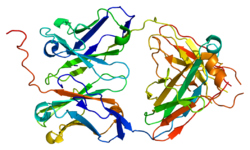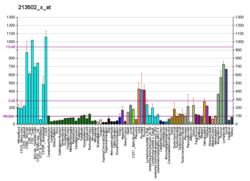
Summary
Immunoglobulin lambda-like polypeptide 1 is a protein that in humans is encoded by the IGLL1 gene.[5][6][7] IGLL1 has also recently been designated CD179B (cluster of differentiation 179B).
| IGLL1 | |||||||||||||||||||||||||||||||||||||||||||||||||||
|---|---|---|---|---|---|---|---|---|---|---|---|---|---|---|---|---|---|---|---|---|---|---|---|---|---|---|---|---|---|---|---|---|---|---|---|---|---|---|---|---|---|---|---|---|---|---|---|---|---|---|---|
 | |||||||||||||||||||||||||||||||||||||||||||||||||||
| |||||||||||||||||||||||||||||||||||||||||||||||||||
| Identifiers | |||||||||||||||||||||||||||||||||||||||||||||||||||
| Aliases | IGLL1, 14.1, AGM2, CD179b, IGL1, IGL5, IGLJ14.1, IGLL, IGO, IGVPB, VPREB2, immunoglobulin lambda like polypeptide 1 | ||||||||||||||||||||||||||||||||||||||||||||||||||
| External IDs | OMIM: 146770 MGI: 96529 HomoloGene: 131669 GeneCards: IGLL1 | ||||||||||||||||||||||||||||||||||||||||||||||||||
| |||||||||||||||||||||||||||||||||||||||||||||||||||
| |||||||||||||||||||||||||||||||||||||||||||||||||||
| |||||||||||||||||||||||||||||||||||||||||||||||||||
| |||||||||||||||||||||||||||||||||||||||||||||||||||
| |||||||||||||||||||||||||||||||||||||||||||||||||||
| Wikidata | |||||||||||||||||||||||||||||||||||||||||||||||||||
| |||||||||||||||||||||||||||||||||||||||||||||||||||
It is associated with agammaglobulinemia-2.
The preB cell receptor is found on the surface of proB and preB cells, where it is involved in transduction of signals for cellular proliferation, differentiation from the proB cell to the preB cell stage, allelic exclusion at the Ig heavy chain gene locus, and promotion of Ig light chain gene rearrangements. The preB cell receptor is composed of a membrane-bound Ig mu heavy chain in association with a heterodimeric surrogate light chain. This gene encodes one of the surrogate light chain subunits and is a member of the immunoglobulin gene superfamily. This gene does not undergo rearrangement. Mutations in this gene can result in B cell deficiency and agammaglobulinemia, an autosomal recessive disease in which few or no gamma globulins or antibodies are made. Two transcript variants encoding different isoforms have been found for this gene.[7]
References edit
- ^ a b c GRCh38: Ensembl release 89: ENSG00000128322 – Ensembl, May 2017
- ^ a b c GRCm38: Ensembl release 89: ENSMUSG00000075370 – Ensembl, May 2017
- ^ "Human PubMed Reference:". National Center for Biotechnology Information, U.S. National Library of Medicine.
- ^ "Mouse PubMed Reference:". National Center for Biotechnology Information, U.S. National Library of Medicine.
- ^ Bauer SR, Huebner K, Budarf M, Finan J, Erikson J, Emanuel BS, Nowell PC, Croce CM, Melchers F (Nov 1988). "The human Vpre B gene is located on chromosome 22 near a cluster of V lambda gene segments". Immunogenetics. 28 (5): 328–33. doi:10.1007/BF00364231. PMID 3139558. S2CID 6981867.
- ^ Schiff C, Milili M, Fougereau M (Dec 1989). "Isolation of early immunoglobulin lambda-like gene transcripts in human fetal liver". Eur J Immunol. 19 (10): 1873–8. doi:10.1002/eji.1830191018. PMID 2511029. S2CID 84544002.
- ^ a b "Entrez Gene: IGLL1 immunoglobulin lambda-like polypeptide 1".
Further reading edit
- Evans RJ, Hollis GF (1991). "Genomic structure of the human Ig lambda 1 gene suggests that it may be expressed as an Ig lambda 14.1-like protein or as a canonical B cell Ig lambda light chain: implications for Ig lambda gene evolution". J. Exp. Med. 173 (2): 305–11. doi:10.1084/jem.173.2.305. PMC 2118775. PMID 1703205.
- Bossy D, Milili M, Zucman J, et al. (1992). "Organization and expression of the lambda-like genes that contribute to the mu-psi light chain complex in human pre-B cells". Int. Immunol. 3 (11): 1081–90. doi:10.1093/intimm/3.11.1081. PMID 1760403.
- Mattei MG, Fumoux F, Roeckel N, et al. (1991). "The human pre-B-specific lambda-like cluster is located in the 22q11.2-22q12.3 region, distal to the IgC lambda locus". Genomics. 9 (3): 544–6. doi:10.1016/0888-7543(91)90422-B. PMID 1903358.
- Tsubata T, Reth M (1990). "The products of pre-B cell-specific genes (lambda 5 and VpreB) and the immunoglobulin mu chain form a complex that is transported onto the cell surface". J. Exp. Med. 172 (3): 973–6. doi:10.1084/jem.172.3.973. PMC 2188549. PMID 2117639.
- Schiff C, Bensmana M, Guglielmi P, et al. (1991). "The immunoglobulin lambda-like gene cluster (14.1, 16.1 and F lambda 1) contains gene(s) selectively expressed in pre-B cells and is the human counterpart of the mouse lambda 5 gene". Int. Immunol. 2 (3): 201–7. doi:10.1093/intimm/2.3.201. PMID 2128466.
- Hollis GF, Evans RJ, Stafford-Hollis JM, et al. (1989). "Immunoglobulin lambda light-chain-related genes 14.1 and 16.1 are expressed in pre-B cells and may encode the human immunoglobulin omega light-chain protein". Proc. Natl. Acad. Sci. U.S.A. 86 (14): 5552–6. Bibcode:1989PNAS...86.5552H. doi:10.1073/pnas.86.14.5552. PMC 297661. PMID 2501791.
- Chang H, Dmitrovsky E, Hieter PA, et al. (1986). "Identification of three new Ig lambda-like genes in man". J. Exp. Med. 163 (2): 425–35. doi:10.1084/jem.163.2.425. PMC 2188038. PMID 3003227.
- Ohnishi K, Takemori T (1994). "Molecular components and assembly of mu.surrogate light chain complexes in pre-B cell lines". J. Biol. Chem. 269 (45): 28347–53. doi:10.1016/S0021-9258(18)46934-7. PMID 7961773.
- Bauer TR, McDermid HE, Budarf ML, et al. (1993). "Physical location of the human immunoglobulin lambda-like genes, 14.1, 16.1, and 16.2" (PDF). Immunogenetics. 38 (6): 387–99. doi:10.1007/BF00184519. hdl:2027.42/46751. PMID 8406611. S2CID 19311673.
- Sohi MK, Corper AL, Wan T, et al. (1996). "Crystallization of a complex between the Fab fragment of a human immunoglobulin M (IgM) rheumatoid factor (RF-AN) and the Fc fragment of human IgG4". Immunology. 88 (4): 636–41. doi:10.1046/j.1365-2567.1996.d01-692.x. PMC 1456622. PMID 8881769.
- Donohoe ME, Blomberg BB (1997). "The 14.1 surrogate light chain promoter has lineage- and stage-restricted activity". J. Immunol. 158 (4): 1681–91. doi:10.4049/jimmunol.158.4.1681. PMID 9029104. S2CID 29592657.
- Kawasaki K, Minoshima S, Nakato E, et al. (1997). "One-megabase sequence analysis of the human immunoglobulin lambda gene locus". Genome Res. 7 (3): 250–61. doi:10.1101/gr.7.3.250. PMID 9074928.
- Corper AL, Sohi MK, Bonagura VR, et al. (1997). "Structure of human IgM rheumatoid factor Fab bound to its autoantigen IgG Fc reveals a novel topology of antibody-antigen interaction". Nat. Struct. Biol. 4 (5): 374–81. doi:10.1038/nsb0597-374. PMID 9145108. S2CID 34331252.
- Minegishi Y, Coustan-Smith E, Wang YH, et al. (1998). "Mutations in the Human λ5/14.1 Gene Result in B Cell Deficiency and Agammaglobulinemia". J. Exp. Med. 187 (1): 71–7. doi:10.1084/jem.187.1.71. PMC 2199185. PMID 9419212.
- Miyazaki T, Kato I, Takeshita S, et al. (1999). "Lambda5 is required for rearrangement of the Ig kappa light chain gene in pro-B cell lines". Int. Immunol. 11 (8): 1195–202. doi:10.1093/intimm/11.8.1195. PMID 10421777.
- Donohoe ME, Beck-Engeser GB, Lonberg N, et al. (2000). "Transgenic human lambda 5 rescues the murine lambda 5 nullizygous phenotype". J. Immunol. 164 (10): 5269–76. doi:10.4049/jimmunol.164.10.5269. PMID 10799888.
- Nomura K, Kanegane H, Karasuyama H, et al. (2000). "Genetic defect in human X-linked agammaglobulinemia impedes a maturational evolution of pro-B cells into a later stage of pre-B cells in the B-cell differentiation pathway". Blood. 96 (2): 610–7. PMID 10887125.
- Fang T, Smith BP, Roman CA (2001). "Conventional and surrogate light chains differentially regulate Ig mu and Dmu heavy chain maturation and surface expression". J. Immunol. 167 (7): 3846–57. doi:10.4049/jimmunol.167.7.3846. PMID 11564802.
This article incorporates text from the United States National Library of Medicine, which is in the public domain.








